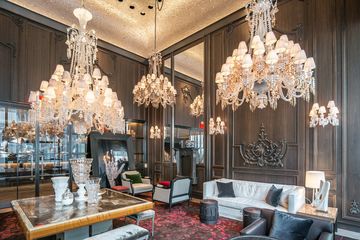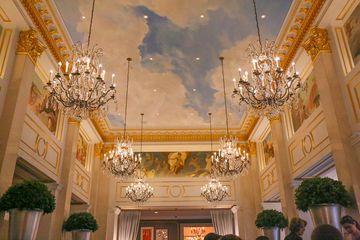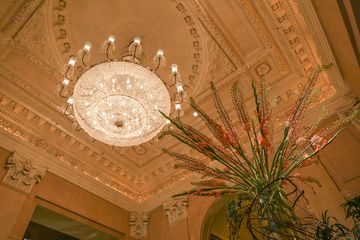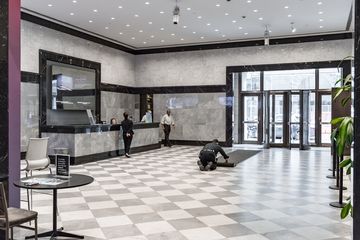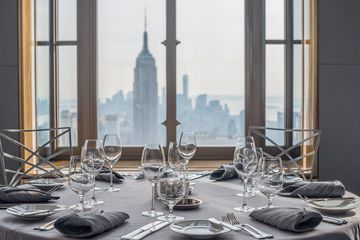“I’ve never seen Central Park look so small, ” our photographer, Tom, exclaimed when we reached the sixty-fifth floor of 30 Rockefeller Plaza. We were gazing out at a dazzling view, seen by the fortunate visitors who ascend the elevators to the Rainbow Room, a dining destination since the mid 1930s that has recently re-opened after a five year “facelift. ” For the time being, the public is invited for brunch on Sundays and dinner on Mondays, with the rest of the week reserved for private events. When the Manhattan Sideways team arrived, the late afternoon sun was streaming through the windows, and it became immediately apparent why the restaurant is known as the “Rainbow” Room. From the crystal "curtains" on the windows to the glass balustrades on the railings, each element turns the rays of light into beguiling dancing rainbows - and the ultimate glittering piece is found in the center of the ceiling where the spectacular crystal chandelier hangs. Above the fixture is a circlet of bulbs referred to as "the globe" that can change color and alter the quality of light emitted from the chandelier in order to match different party themes. If looking up was not enough to wow each of us, the marketing team giving us the grand tour then directed our eyes down to the other centerpiece of the room: the rotating dance floor. We were happy to learn that just as much dancing happens today as in the 1930s. We were told that in the weeks since the Rainbow Room unveiled its new look, guests have been eagerly stepping onto the gently spinning disk each night. The two women guiding us through the space agree that this is part of the allure of the Rainbow Room, as it is one of the few places in the city where patrons can dance in ways they are unable to in a nightclub. When I asked the ladies if they had had the chance to try out the dance floor, one of them grinned and admitted that yes, indeed she had. She described the exciting, dizzying feeling of stepping off in between songs to return to her table. I did not have the pleasure of experiencing the dance floor some twenty plus years ago, but I do remember an enchanting evening when I listened to my childhood idol, Leslie Gore, sing some of her classic songs from the 60s including, "Sunshine, Lollipops and Rainbows! "The Rainbow Room is not the only dining establishment on the sixty-fifth floor. Down the hall, past the covered seating area called “the gallery, " SixtyFive was bathed in the light of the sunset. The bar has an excellent after-work vibe with a direct view of the Empire State Building. It also has a new balcony where outdoor seating is available and allows for some of Manhattan's most breathtaking and majestic views. "I am thrilled to be part of an iconic reopening, a part of New York history, " Molly Cohen, the beverage director, declared. While spending time with us, sharing the joy of traveling up sixty-five floors to her job every evening, she explained that she was in charge of creating the exciting cocktail list, broken down in the menu as either “classic” or “contemporary. ” Molly said that her goal is to pay homage to the traditional drinks (since modern mixology "began at the Rainbow Room") and to keep everything simple but imaginative. She is not a fan of being “fussy for the sake of being fussy, ” and prefers uncomplicated drinks that are very well thought-out. She continued by saying that she is equally proud of her wine list. "It is easy to create an excellent cocktail, but harder to please wine drinkers. " Molly encourages people to think of SixtyFive as a great place to return to for a night with friends or business associates, not just as a location for special occasions. She believes that there is a magical quality about the Rainbow Room and SixtyFive: “It’s hard to have a bad time. ”While sitting by the windows, peering out over New York, sipping on cocktails, and sampling some of the new, incredible food items rolling out that evening, we had the pleasure of speaking to Keith Douglas. As the managing director, he told us that he has been a central player during the renovation. He shared the story of bringing up pieces of the old dance floor and finding confetti and newspaper clippings from the 1940s. As he is planning the future of the Rainbow Room, he says he keeps remembering those hidden memories. He thinks about how in eighty years time, another crazy managing director could pull up the floor, see his name, and ask, “Who’s Keith Douglas? ”
